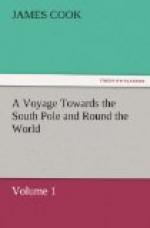CHAPTER III.
Sequel of the Search for a Southern Continent, between the Meridian of the Cape of Good Hope and New Zealand; with an Account of the Separation of the two Ships, and the Arrival of the Resolution in Dusky Bay.
1773 January
After meeting with this ice, I did not think it was at all prudent to persevere in getting farther to the south; especially as the summer was already half spent, and it would have taken up some time to have got round the ice, even supposing it to have been practicable; which, however, is doubtful. I therefore came to a resolution to proceed directly in search of the land lately discovered by the French. And, as the winds still continued at E. by S., I was obliged to return to the north, over some part of the sea I had already made myself acquainted with, and, for that reason, wished to have avoided. But this was not to be done, as our course made good, was little better than north. In the night the wind increased to a strong gale, attended with sleet and snow, and obliged us to double-reef our top-sails. About noon the next day the gale abated, so that we could bear all our reefs out; but the wind still remained in its old quarter.
In the evening, being in the latitude of 64 deg. 12’ S., longitude 40 deg. 15’ E., a bird, called by us in my former voyage Port Egmont Hen, (on account of the great plenty of them at Port Egmont in Falkland Isles,) came hovering several times over the ship, and then left us in the direction of N.E. They are a short thick bird, about the size of a large crow, of a dark-brown or chocolate colour, with a whitish streak under each wing, in the shape of a half-moon. I have been told that these birds are found in great plenty at the Fero Isles, North of Scotland; and that they never go far from land. Certain it is, I never before saw them above forty leagues off; but I do not remember ever seeing fewer than two together; whereas here was but one, which, with the islands of ice, may have come a good way from land.
At nine o’clock, the wind veering to E.N.E., we tacked and stood to the S.S.E, but at four in the morning of the 20th, it returned back to its old point, and we resumed our northerly course. One of the above birds was seen this morning, probably the same we saw the night before, as our situation was not much altered. As the day advanced, the gale increased, attended with thick hazy weather, sleet, and snow, and at last obliged us to close-reef our top-sails, and strike top-gallant-yards. But in the evening the wind abated so as to admit us to carry whole top-sails, and top-gallant-yards aloft. Hazy weather, with snow and sleet continued.




